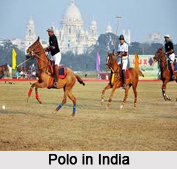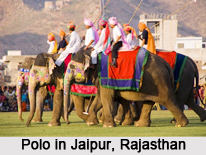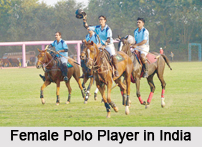 Polo came to India with the hands of British East India Company’s officials. But from some sources, it is found that Polo has an ancient origin. The kings of Manipur and the Mongoloid races used to play polo from ancient eras. The Indian state of Manipur is considered to be the birthplace of Polo, according to the English Guinness Book of World Records findings. Hence, Manipur is called as the 'Home of Polo'.
Polo came to India with the hands of British East India Company’s officials. But from some sources, it is found that Polo has an ancient origin. The kings of Manipur and the Mongoloid races used to play polo from ancient eras. The Indian state of Manipur is considered to be the birthplace of Polo, according to the English Guinness Book of World Records findings. Hence, Manipur is called as the 'Home of Polo'.From 'Sago Kangjei' to Polo
The traditional Manipuri game named 'Sago Kangjei' is the mother of the modern day Polo. After its inception, the game earned huge popularity among the Indians, especially among the Indian emperors and kings. The game also became a tool to promote equestrian and military skills and it acted like a test of skill of princes and warriors.
Medieval History of Polo in India
The Mughal Dynasty in India played an important role in the rising of Polo as a popular game in India, during the medieval period. Among the great Mughal Emperors, Babur was a great polo player himself, and patronised Polo in India in a great way. Akbar too played a crucial role in supporting polo in India. He had set some rules for the game and also had a huge stable near Agra. Polo in India was considered as the national sport at that time. The builder of Qutub Minar, Sultan Qutub Uddin Aibak died of a fatal accident after a fall on the polo field in Lahore, which is located in modern Pakistan.

Modern History of Polo in India
During the British period, the famous British Captain Robert Stewart along with few British officers and tea planters brought the modern form of Polo known as 'English Polo' in India. They brought the game at Silchar and Cachar District in Assam in 1859 and this is considered to be an important landmark in the history of polo in India. They learnt the game from the Manipuri military men, who were then living in Cachar along with the king, Maharaj Chandra Kirti Singh. The British rulers also set up a Polo Club at Borjalenga in Silchar, Assam, which is famous for being the oldest Polo club in the world. The modified form of polo started in India in 1863, when after two Manipuri teams played Sagol-Kangjei at Kolkata. Polo was also concentrated in the Indian states like Rajasthan, Punjab, Jammu and Kashmir, Assam and Madhya Pradesh.
Types of Polo in India
There are three different types of polo, which are played in the country, namely horse polo, camel polo and bicycle polo. Horse polo is a traditional game of the Indian state of Rajasthan, though today it is practised in the Indian cities like Mumbai, Kolkata and Delhi. The camel polo is being played in several regional fairs of Rajasthan, purely for the purpose of entertainment.
Rules of Polo in India
 Rules of polo have been purposely kept simple in order to make people understand. In polo, the players play a ball game with a stick, while riding a horse. Two teams having four players on four horses play the polo in India. The ground of polo in India is generally of 230 to 275 metres in length and 146 to 180 metres in width.
Rules of polo have been purposely kept simple in order to make people understand. In polo, the players play a ball game with a stick, while riding a horse. Two teams having four players on four horses play the polo in India. The ground of polo in India is generally of 230 to 275 metres in length and 146 to 180 metres in width.